Wildflower meadows - a practical approach
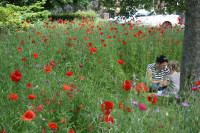
Wildflower Turf Ltd's Managing Director, James Hewetson-Brown, discusses the various methods of establishment
In theory, wildflower areas would seem an attractive proposition to most groundcare professionals. Not only are they aesthetically pleasing but there is little maintenance required once the meadow is established. A wildflower area will need just one cut a year, where all of the arisings are collected from the site. Watering requirements are low, wildflowers are resilient to drought and, in fact, will perform better in drier years.
There is no requirement for fertiliser or pesticides in order to keep the wildflowers competitive with invasive grasses; wildflowers flourish in low nutrient soil. With these factors ticking the environmental boxes, along with the obvious benefits for wildlife with regard to food source and habitat creation, you would imagine parks and golf courses, up and down the land, keen to convert vast areas of space to wildflower. As attractive as it sounds, successfully establishing a wildflower area is a landscaper's nemesis.
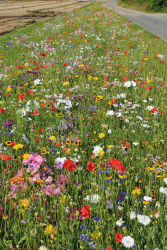
In the media. there have been plenty of high profile 'landscape experts' who would have you believe that by raking through a patch of grass and throwing some wildflower seed over the top, you will very quickly have a beautiful wildflower meadow. The reality is all too often different, with the amount of work involved to establish a meadow more likely to be years rather than weeks.
The early years of a planned meadow can mean plenty of clearing, weeding and mowing. Alternatively, there is more of a scientific approach, with books and papers written about seed mixes and the relationship between one species and another and how they will or will not coexist in a meadow. These approaches are polar opposites - one too simplistic to actually work and one too complicated to engage more than the most ardent enthusiast.
Whilst much has been done to promote the benefits of having a perennial native wildflower meadow, little has been put forward to provide a proven, workable solution for the creation of a meadow. Therefore, an understanding of the methods of establishment of wildflowers is crucial in managing the expectations of the meadow maker. A pragmatic approach, providing sensible and realistic solutions, is essential if our natural landscapes are to benefit from the current resurgence of interest in wildflower meadows.
Methods to establish a wildflower area
Let's look first at the different establishment methods that can be used to create a native perennial wildflower area.
Natural Regeneration of Grassland
This method can be used on an area of existing grassland or lawn, and is often known as naturalising. In its simplest form, it means leaving the area to grow and allowing nature to run its course. The area will naturally develop with just a small amount of management required.
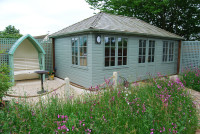
Whatever is already in this area or naturally migrates to the site, will be allowed to grow with just one annual cut. By changing management regime and techniques, seeds that have remained dormant in the soil for years may decide the time is right to make an appearance. By leaving it to nature, you relinquish control over what may grow and it is likely that, whilst biodiversity will be increased dramatically over the years, the overall visual representation of wildflowers may be less satisfying and the number of species limited in the short to medium term.
Whilst there is a minimal amount of work and effort involved with this methodology, the timescale is certainly years and not months and the overall look, without intervention, is more likely to resemble an unkempt hay meadow rather than a colourful wildflower meadow with a lower yield of wildflowers and biodiversity.
With knowledge, enthusiasm and a great deal of time, naturalising can be a great approach. It is a low cost method that works if there are realistic expectations on the amount of time and the amount of flowers that you would expect to see.
Seeding

Creating a new seed bed will awaken existing weed seeds that are already within the soil. This undesirable seed bank will need to be dealt with in order for the wildflower seeds to flourish. In addition, the quality of the seed will play a large part. Currently, in the UK, there is no independent testing of wildflower seed and, for the inexperienced meadow maker, seed choice can be a bit of a lottery.
This is just the start of the process and, whilst you can have success eventually, expect a lot of on-going work in order to get the best from the species you have introduced. Cutting, removing and spot spraying will keep you busy for the first 3-5 years. It is rare to hear of any long term success with perennial wildflower seed that doesn't involve a lot of detailed planning, followed by hard work over a number of years.
It is possible to get better seeding results with annual wildflowers as they are more able to compete with the weeds. There are very competitive and commercially available non-native seed mixes bred and developed to deliver reliable results.

The Olympic Park is a good case in point. Here, much of the success was due to the use of carefully manufactured soil that had little or no weed burden and, whilst the flowers did work well without requiring an extended period of establishment and maintenance, there were a number of years of on and offsite testing in advance of the Games to ensure success and results for an immovable deadline.
Turfing
Using a pre-grown wildflower turf is a relatively recent introduction in the establishment of wildflower meadows. As a modern and high input technique, it has the benefit of much attention to detail and has been tried and tested to give optimum and reliable results. A mat of pre-established wildflower plants is nursery grown, set in appropriate quantities to provide an even distribution of species. There are no existing weed seeds within the product as good quality wildflower seed is sown and, therefore, there is no competition whilst the plants are establishing.

The result is a complete meadow, much further along its evolutionary scale than one could hope to get after ten years of naturalising. The meadow maker can specify exactly the mix of seeds that they would like and, should they be working on a project where maintaining the local mix of flora is important, locally harvested seed can be used.
Not only are you more likely to have success with the plants that you do want, but you also have more control over the weeds that you don't want. The turf is a densely networked root mat that supports its healthy, established and instantly competitive wildflowers above it. The massed density of roots in the turf act as a weed suppressing carpet, smothering any seeds that are in the soil and on the point of germinating.
Whilst this is the most guaranteed method of creating a meadow, initial cost is higher than seeding. It is perfect for the meadow maker wanting immediate, guaranteed and risk free results.
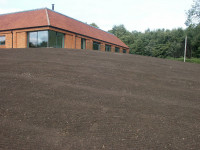
As demand has developed for a workable solution to the creation of much larger wildflower areas, Wildflower Earth™ is an alternative installation method to wildflower seeding that is an easy and quick solution, with a far greater guarantee of success than wildflower seed alone.
The growing medium provides an optimum seed rate, blended with premium growing medium ingredients, to give exceptional levels of wildflower seed germination and establishment.
This specially developed growing medium provides perfect growing conditions, akin to an envelope of goodness surrounding the seed, whilst also helping to suppress weed seeds that are below this layer of material. It provides a reliable result in terms of attractive bio-diverse wildflower displays for landscaping projects, whilst requiring considerably less investment in ground preparation.
Areas to be covered need a general spray off with glyphosate 2-3 weeks prior to installation. The growing medium is spread to a depth of 25mm directly on top of the treated area and, therefore, provides a blanketing effect to potential weed seeds lurking in the soil below.
As no tilth creation is required, the new seedlings are less likely to be competing with weed seeds that have been turned over. Installation is best suited to the spring and autumn growing periods, although summer installation works if irrigation is applied. There is no instant green coverage as with the turf but, due to the medium the seed is set within, you can expect quick germination and establishment.
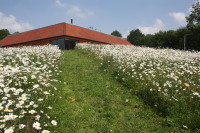
Successful wildflower establishment is dependent on quick and robust seedling growth providing competitive plant development. This method grows strong and competitive plants, vital for successful and risk free wildflower establishment.
Which method to choose?
Whichever method is adopted, the resultant landscape will be a wildflower meadow of sorts, but the differentiators are the work and time involved, the costs, the range and diversity of species and the look and visual impact of the meadow. Expectations must be realistic. The desire for wildflower meadows has never been greater, but the process of establishing them is always overlooked and underestimated.
So, in order to satisfy all of the above criteria, adopting a modern approach to meadow making is essential. The rather historic or even romantic view of using locally collected seed sown over an existing lawn or grass sward, and then scything it once a year to maintain it, is likely to end in disappointment at best, or considerable frustration at worst!
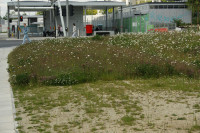
To meet these objectives, those involved have to be confident of achieving results that suit all of these demands. It is not good enough to have the interests of the ecologist met with species rich habitats if the species are nettles, docks, thistles and ragwort. The customer will not want this and will not be prepared to pay for it.
The landscape professional demands reliable results to avoid time consuming problems and the need for remedial action. And, in this day and age, the customer wants quick, if not instant results. To satisfy these stakeholders, as well as the bees and butterflies, beautiful, nectar rich habitats are needed rapidly. Embracing the use of modern establishment techniques will deliver reliable, risk free results that should delight all involved.



